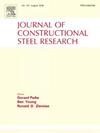Experimental and theoretical investigation of beam-to-upright subassemblies for HBSSR against progressive collapse
IF 4
2区 工程技术
Q1 CONSTRUCTION & BUILDING TECHNOLOGY
引用次数: 0
Abstract
This paper presents an experimental and theoretical investigation into beam-to-upright subassemblies in the high-rise braced steel storage racks (HBSSR) during a progressive collapse. A total of five double-half-span subassemblies were tested under a middle-column-removal scenario, involving various pallet loads, beam spans, connection types and bolt numbers. Three main failure modes, including tab cracking, bolt bearing and beam end failure and their combination, were observed in the tests. The development of the collapse-resisting mechanisms in the subassemblies are analyzed. Both flexural action and catenary action contribute to the collapse resistance of the subassemblies, with catenary action dominating ultimate resistance. The effects of critical geometric parameters on the collapse-resisting performance are also investigated. The ductility of the subassembly is improved when the beam span increases and the pallet loads exist. For Tab + Bolt (TB) connections, increased bolt number leads to increase of ultimate resistance and to decrease of ductility. For purely-bolted (PB) connections, increased bolt number impairs both ultimate resistance and ductility. Therefore, compared with the PB connections, the TB connections are preferable due to their better ductility in the collapse-resisting design. Moreover, a theoretical model based on the Component Method is developed to characterize the full-range load-displacement behaviour of beam-to-upright subassemblies. Validated against test results, the proposed model shows proper predictions of load-displacement curve and failure phenomenon.
求助全文
约1分钟内获得全文
求助全文
来源期刊

Journal of Constructional Steel Research
工程技术-工程:土木
CiteScore
7.90
自引率
19.50%
发文量
550
审稿时长
46 days
期刊介绍:
The Journal of Constructional Steel Research provides an international forum for the presentation and discussion of the latest developments in structural steel research and their applications. It is aimed not only at researchers but also at those likely to be most affected by research results, i.e. designers and fabricators. Original papers of a high standard dealing with all aspects of steel research including theoretical and experimental research on elements, assemblages, connection and material properties are considered for publication.
 求助内容:
求助内容: 应助结果提醒方式:
应助结果提醒方式:


